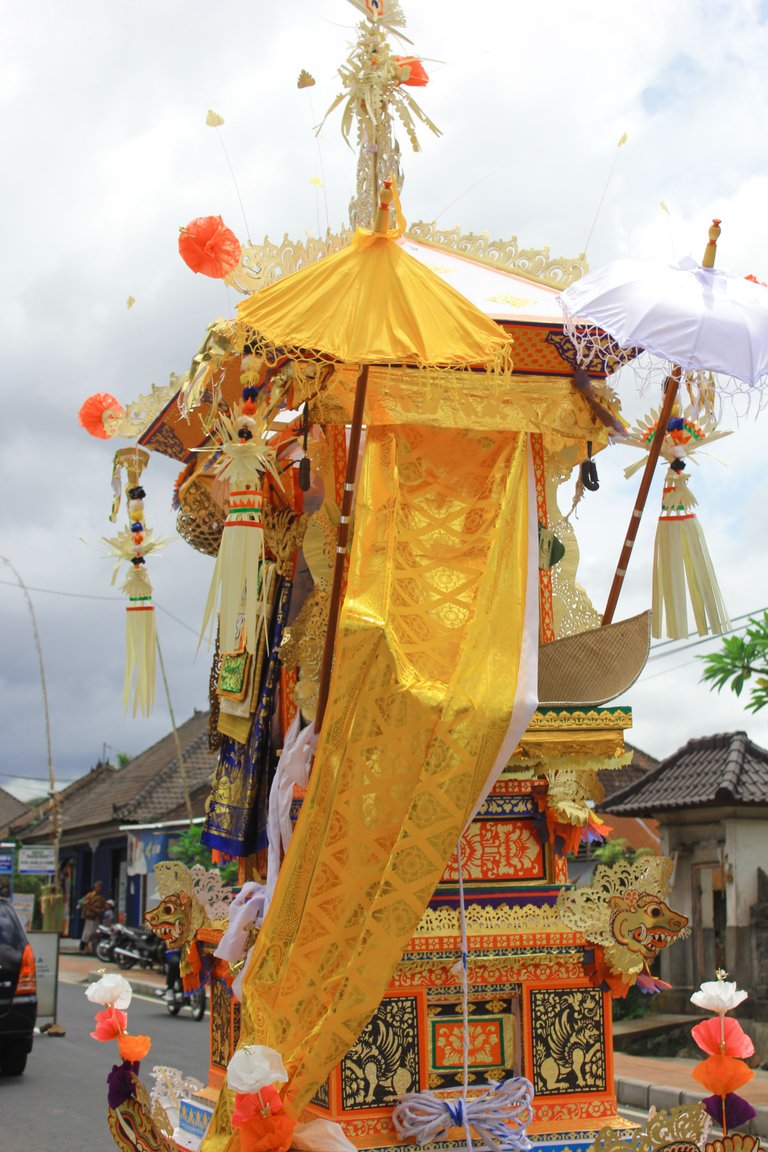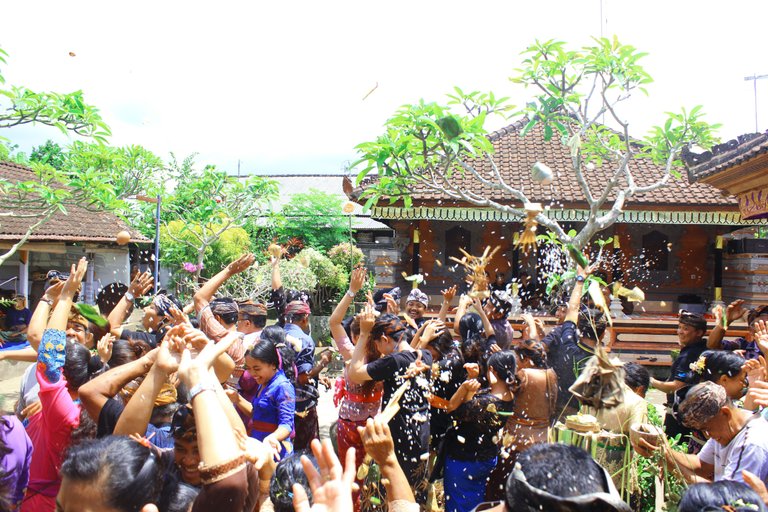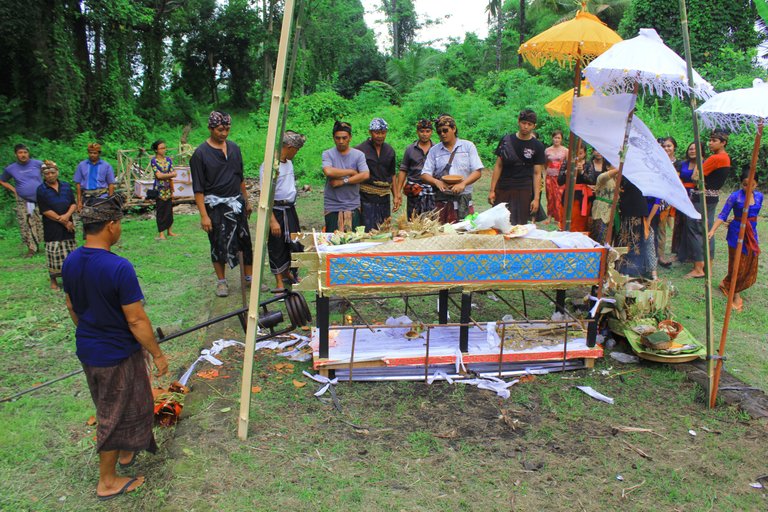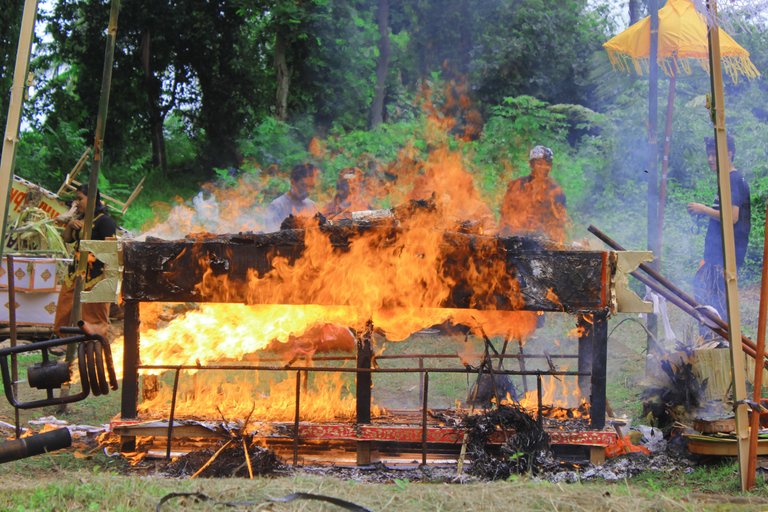Ngaben is the burning of the bodies or the cremation ceremony in Bali, Indonesia. Traditional ceremony Ngaben is a ritual done to send the corpse on the life to come.In this ceremony, the bodies were placed with positions such as people slept. Families left behind will assume that the people who died were asleep. In this ceremony, no tears because they assume that the bodies are just not there for a while and undergoing reincarnation or will find final resting in Moksha i.e. a State which has been free of the soul from reincarnation and death. Ceremony ngaben is also the symbol for cleansing the spirit of people who have died.
In the teachings of Hinduism, the human body is composed of a subtle body (spiritor atma) and rough body (physical). Rugged body constituted by the five elementsknown Maha Bhutas Panca. The fifth element terddiri of the Earth (ground), cassia (fire), apah (water), vayu (wind), and akasa (vacuum). Five of these elements coalesce to form a physical and then moved by the spirit. If someone died, the dead is actually just a ballpark remains alone while his spirit did not. Therefore, to cleanse the spirit, needs to be done to separate the Cremation ceremony of spirit with the bodies of the ballpark.
The purpose of the ceremony ngaben
Generally the magnitude of Cremation is to process the return of Panca Mahabhutain nature of this great and accompany the Atma (spirit) to nature Pitra by deciding that earthly body shake. With a decided passion for Atma (spirit) and his world, he would be back on its natural, i.e. natural Pitra. Then become a destination ceremony ngaben is so ragha sarira (body/body) can quickly back towards its origin, namely the Pañca Maha Bhutas in nature and Atma survived can be left for natural pitra.
In general the implementation of a series of ritual ceremony cremation culture is as follows:
Ngulapin, Ngulapin meaning as ceremonies for terbuktigil The Atma. The ceremony was also held in question died outside the home in question (like in the hospital, etc.). The ceremony is carried out do not match according with the local traditions and the tutorials, some are carrying out in the intersection, Junction Road, and the local cemetery.
Nyiramin or Ngemandusin, is the ceremony of bathing and cleaning the corpse, the ceremony is a regular family home page dilsayakan yangbersangkutan (natah). In this procession is also accompanied by the granting of such symbols of jasmine flowers in the nasal cavity, glass hemisphere above the eyes, leaves intaran in the eyebrows, and other appliances with the aim of restoring back the benefits of the body that is not used to its origin, and in the spirit of late experienced reincarnation back so that was awarded the Agency a complete (not disabled).
Ngajum Kajang, Kajang is a piece of white paper inscribed with magical scripts by stakeholders, pastor aka local cultural elders. After the end is written, the relatives and descendants of the concerned will perform the ceremony ngajum kajang with tutorial pressing the kajang at least 3x, as a symbol of the heart's stability relatives release the departure of the deceased and unite the hearts of the relatives so the deceased can quickly travel to the next nature.
Ngaskara, Ngaskara means the purification of the spirit of the deceased. This purification is done with the aim that the spirit concerned can be united with God and can be a teacher of his relatives who remain destiny in the world.
Mameras, Mameras derived from the word squeeze which means successful, successful, aka ends. This ceremony is performed when the deceased has grandchildren, because it is the belief that the grandson will lead the way of the deceased through the prayers and good karma they deserve.
Papegatan, Papegatan comes from the word pegat, which means breaking up, the meaning of this ceremony is to break the worldly relationships and love of the relatives of the deceased, because these two factors will hinder the journey of the spirit toward God. With this ceremony the family means to have sincerely removed the departure of the deceased to a better place. The ingredients of this ceremony are offerings (banten) arranged on a stone mortar and above it is filled with two branches of dadap formed a kind of wicket and stretched white thread on both branches of the tree. Later this thread will be infiltrated by relatives and bearers of the corpse before leaving the house to break up.
Pakiriman defer payment, then papegatan After the ceremony will proceed with the pakiriminan to the local cemetery, along with the bodies of kajangnya then raised to the top of Bade / Containers, the tower pallbearers (this is not a mandatory principal, could be replaced with a plain casket called Pepaga). From the house in question society's men will carry all the bodies and their ceremonial paraphernalia accompanied by sound Baleganjur (Balinese gong) pounding and eager, voice alias angklung looks disappointed. On the journey to the grave this corpse would be paraded rotates counterclockwise 3x meaningful as a symbol of Panca Maha Bhuta restore elements to their respective places.
Not only that this turnaround is also meaningful:
Spinning 3x in front of the deceased's house as a farewell symbol with relatives.
Spinning 3x at the intersection and the village junction as a parting symbol with the community environment.
Spinning 3x in front of the grave as a symbol of parting with this world.
Ngeseng, Ngeseng is a ceremonial burning of the corpse, the corpse was laid in the space provided, accompanied by offerings and offerings with philosophical meaning himself, then sprinkled by the priest who presided over the ceremony at Tirta pangentas that act as fire abstract accompanied by Puja Mantra of the pastor, after ending then then the bodies were burned to charred bones combustion products then crushed and assembled again in the ivory palm fruit that has issued the water.
Nganyud, Nganyud meaningful ritual to sweep all the garbage that remains behind in the spirit of late with the symbols in the form of washed ashes. This ceremony is usually performed in the sea, aka the river.
Makelud, Makelud is usually held 12 days after the funeral ceremony. The meaning of this makelud ceremony is to cleanse and purify the family environment of the impact of disappointment that struck the abandoned family. This 12-day philosophical disappointment was taken from the Wiracarita Mahabharata, when Sang Pandawa experienced a 12-year sentence in the jungle.



